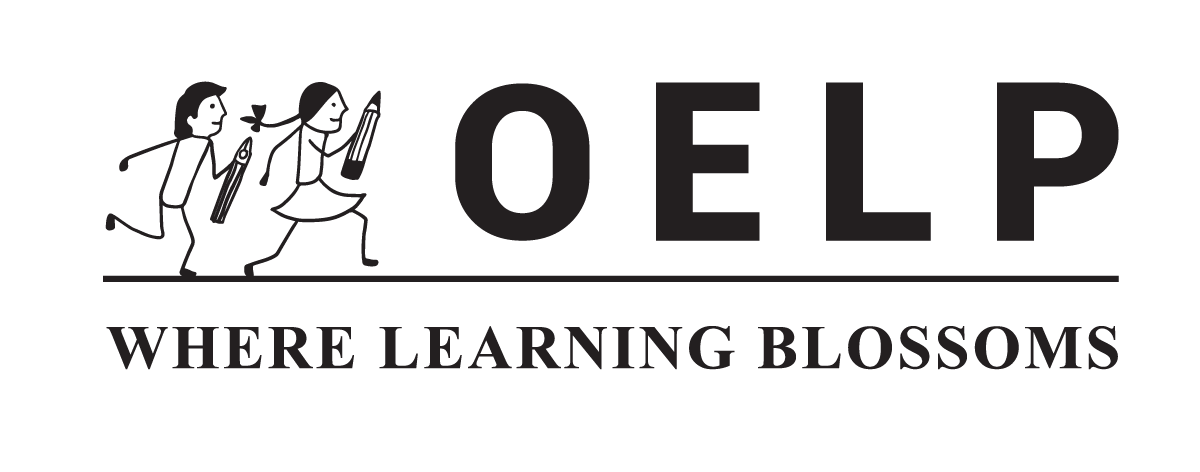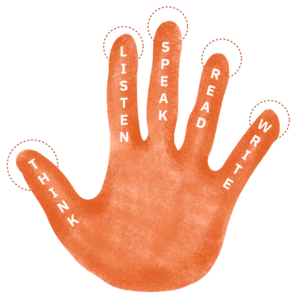Innovations
1) Varna Samooha Approach
The Varna Samooha approach has been developed to make decoding a meaningful process. The pictorial presentation shared here has tried to provide an overview of the classroom processes and underlying thinking of OELP’s Varna Samooha approach.

2) OELP’s Hand For Emphasising the Role Of “Thinking”
OELP believes that becoming literate cannot be limited to learning the alphabet or being able to read or write and respond to prescribed texts.
We believe that becoming literate means:
- Being able to think independently
- Being able to make sense of what one sees, hears or reads
- Being able to share one’s ideas, thoughts and feelings through spoken, pictorial or written communication
The hand helps educational practitioners understand the pivotal role of thinking as the key factor for imbibing meaningfulness to the four aspects of language and literacy i.e. listening; speaking; reading and writing. It is only when we create planned and authentic opportunities for children to reason; to reflect; to draw inferences; to predict; to question or narrate in their own words that meaningful language and literacy learning occurs. Teachers within the programme, even at the Class 1 level are being gradually equipped to create such planned opportunities for each of these four areas of language and literacy learning, so that they generate higher order thinking.
3) Planned Print-rich Classrooms
Planned spaces at OELP are created with low-cost resources for using the classroom walls for meaningful learning. Children are encouraged to engage with all spaces and print elements in a variety of natural ways through games and planned activities. Attention is paid to classroom management techniques and ways of addressing differences such that each child feels accepted and learning occurs in an environment of mutual trust and respect. Every OELP classroom has the following corners:
Reading Corner: Helps with building motivation and a habit to read by providing informal and non-threatening opportunities for meaningful reading.

Poem Corner: Provides young children the motivation to read written forms of poems that can be recited in informal and non-threatening settings.

Word Wall: Supports with building phonological awareness in young readers as well as other literacy skills like word recognition and meaning construction. It also helps build engagement with written forms of language in a variety of enjoyable ways.

Name Displays and / or Attendance Charts: Builds a sense of self and belongingness. It also helps understand that letters have names and are different from each other in shapes and sounds.
Name Displays and / or Attendance Charts: Builds a sense of self and belongingness. It also helps understand that letters have names and are different from each other in shapes and sounds.

Calendar: Helps build foundational concepts of maths like data processing, number operations, and skill of questioning.

Display of Children’s Work: Supports with the development of self-confidence and a positive self-image.
Display of Children’s Work: Supports with the development of self-confidence and a positive self-image.

4) Kahani Mela
The Kahani Mela has been conceptualized with the aim of building communities of engaged readers within low-literate and rural societies along with helping them build deeper connections with books.

Key features of each Kahani Mela are as follows:
- Is a culmination and part of a larger event and not a stand-alone event
- Is a planned fun event with clear objectives
- Is designed to involve children as partners/ co-creators of the event and not as mere passive recipients or spectators
- Is community-led as each mela is supported by resources generated from within the village communities
- Is learning-oriented for everybody involved – young and old
- Creates pride in the local culture and knowledge base




Find the resources to conduct Kahani Melas in your schools and communities:

Kahani Mela Guidelines

Organising Kahani Melas
Organising Kahani Melas- Video

